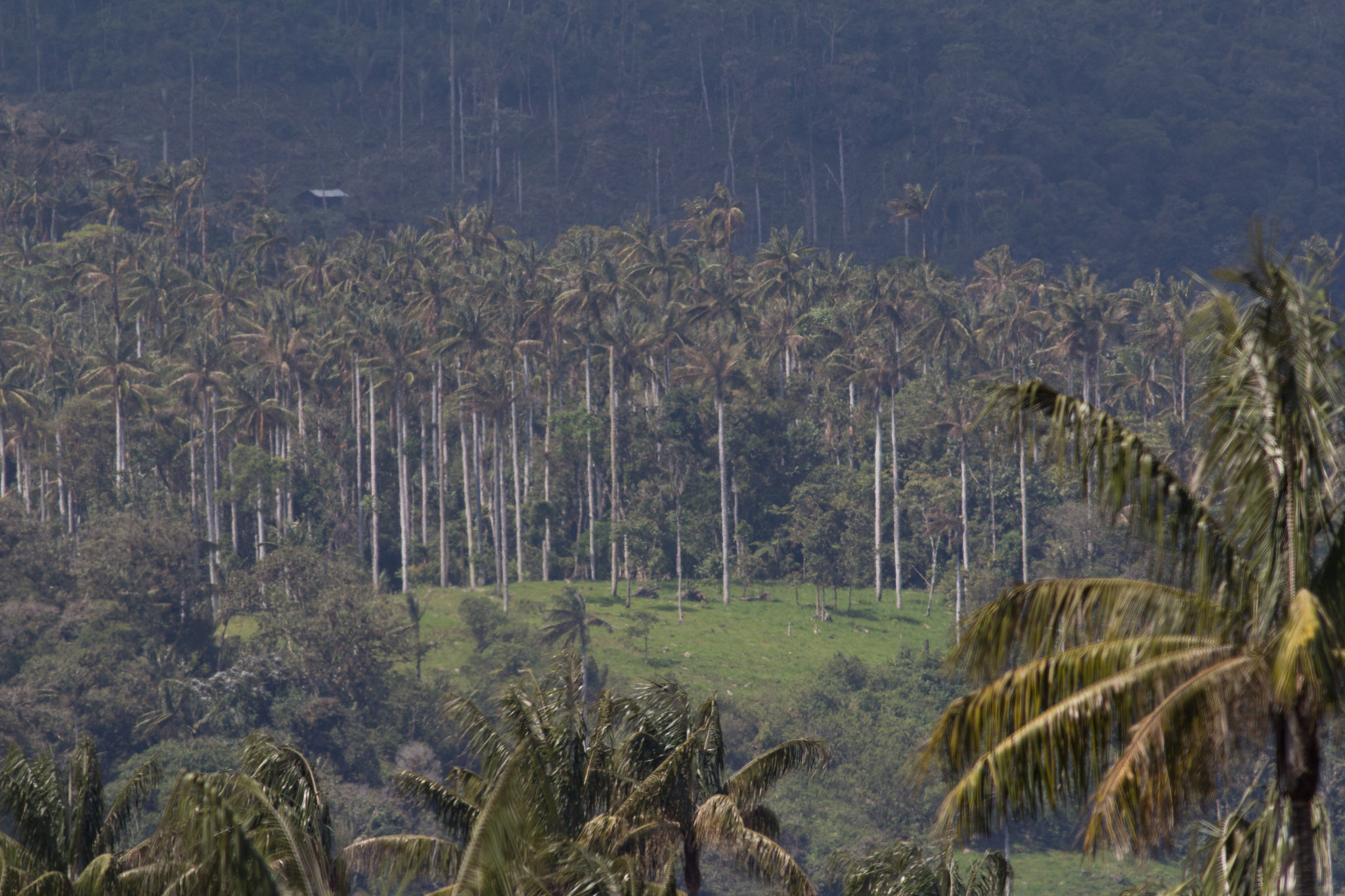Concluded Projects
Over the years we have been engaged in a wide variety of projects around the globe. Below are some examples of recently completed projects.
Our previous work has focused on vegetation, regeneration processes, germination of indigenous forest species and plant use among a wide variety of indigenous societies in Kenya, Tanzania, Ethiopia and Cameroon.
Palms and palm use in northwestern South America
Palms (Arecaceae) are a large family of plants with about 2,500 species and are of economic importance to many countries and indigenous peoples of the tropics. They are found in the humid tropics and subtropics and are highly diverse in the Malesian and Neotropical regions but scarce in the African subcontinent. Palms are a major component of tropical ecosystems and occupy many diverse habits. They grow abundantly in wet lowlands, mangrove swamps, along river edges, in the under-storey of rainforests, in high mountainous regions and in secondary forests. They provide important food resources for animals living in these habitats. Indigenous peoples not only hunt these animals that feed on palms, they also use palms for their daily needs. Traditional uses of palms include: leaves for thatching, basketry and weaving, palm trunks for house construction, rattan for making furniture, palm fibers for strong twines, oil from coconuts and oil palms, fermented palm sap and fruits for alcoholic beverages, palm fruits and palm hearts for food, sago starch from the pith of the sago palm and for multiple medicinal purposes. This myriad of palm uses make them among the most exploited of plants on earth by humans.
The WLBC, in cooperation with PALMS—Palm Harvest Impacts in Tropical Forests, a project funded by the Seventh Framework Program of the European Union (see PALMS-FP7) is putting together a series of publications in Spanish on the use of palms among indigenous peoples of Peru and Bolivia. The first six books are now available in pdf format. Visit our books list for information and free download.
Vegetation ecology of Southern Ecuador
The border region of Ecuador and Peru is one of the Earth’s most biologically diverse areas, and thus a “hotspot of biodiversity” par excellence. Low passes in the Andean chain allow an easy exchange between the floras and faunas of the Amazon Basin and the Pacific lowlands. Additionally, the region shows a very fast transition between the humid mountain forests of the northern Andes and the dry, deciduous forests of the northern Peruvian lowlands. Until the recent past, the Podocarpus National Park and the study area have been almost unknown scientifically.
Studies of the composition and regeneration of the forest vegetation of Reserva Biológica San Francisco have been carried out since 1997 as part of the DFG Project “Functionality in a tropical mountain forest: Diversity, dynamic processes & use-potential under ecosystem aspects”. The intention of these investigations is to characterise the different forest types and their regeneration stages along ecological gradients, and to evaluate whether a detailed characterization is already possible by means of a physiognomic approach, or whether a detailed phytosociological analysis is necessary.
Ethnobotany and livelihoods in Madagascar
The Madagascar Ethnobotany Program is based on the premise that working with local people is the most effective way to conserve biodiversity-rich areas sustainably. By integrating ethnobotanical data into conservation plans, we collaborate with communities to develop a program that will not only protect and replenish the ecosystem but agree with their daily lives and cultural practices.
The program is a collaborative effort with the William L. Brown Center at Missouri Botanical Garden and the University of Antananarivo and the Malagasy communities.
Capacity building: We have partnered with the University of Antananarivo to train Malagasy graduate students in the methods of ethnobotany and provide valuable field experience. Additionally, we aid the faculty of University of Antananarivo in supporting ethnobotanical research and courses. Within the communities we train community members to become forest rangers and serve on conservation committees.
Conservation: We aim to strategize with local populations on how to use their natural resources sustainably so they can become wise stewards of their environment. We work with these communities to develop conservation plans that are both ecologically beneficial and culturally appropriate. We also firmly believe that the preservation of traditional knowledge is a key component in both conservation and sustainability.
Scientific research: Ethnobotanical research and inventories add new information and perspectives on the plants of Madagascar. Our research is scientifically rigorous and shared with the world wide community through scientific publications.
Quality of Life: Improving the living conditions is a fundamental part of the work we do in each community. Our program is based on the belief that in order to permanently solve poverty in biodiversity-rich but economically-poor countries, environmental activities must be linked closely to developmental activities. We also believe an educated, healthy community leads to better decision-making.
Ethnobotany of Kailash Sacred Landscape Nepal: Ecology, Ethnography and Ethnomedicine
Nepal holds much of the biological and cultural diversity of the Himalayan region. This diversity is structured not only over the steep north-south elevational gradient, but also over an east-west gradient of precipitation, with eastern Nepal receiving ten times more monsoon rainfall than western Nepal. The country’s diverse indigenous groups speak 120 languages, and an estimated native 2000 plants are in common use as medicines, foods, fodder, religious purposes, etc. Especially in mountain communities, these useful plants are vital, in some areas collected by virtually all households, and providing half of the household income
The dialectical relationship between indigenous knowledge and practices shape the ecosystem and affect the constituent plant populations. Indigenous knowledge and use have to be explicitly analysed so that appropriate management measures that build on both scientific and local knowledge may be developed for management of both indigenous knowledge and plant populations. However, due to changing perception of the local people, commercialisation and socio-economic transformation all over the world, there has been a general observation that the indigenous knowledge on plant resource use has degraded. Due to lack of organised and scientific cultivation, proper management, and awareness of social factors, the number of useful plant resources is decreasing at an alarming rate. Furthermore, the indigenous knowledge on use of lesser-known plants is also rapidly declining. The present study therefore assesses the diversity study of plant population in West Nepal and scopes the relationship of plant diversity and indigenous uses of plant resources along altitudinal and longitudinal gradient.
The general objective of the study is to analyse the plant diversity and ethnobotany along altitudinal gradient.
To study the plant diversity of west Nepal;
To document the indigenous uses of plant resources of west Nepal;
To document the relationship of plant diversity and indigenous uses of plant resource along altitudinal and longitudinal gradient and standardize the module of interrelationship;
To analyze the biochemical assessment of some ethnobotanically important plant species and plot their major compounds along altitudinal gradient;
To compare ethnomedicinal information of the selected species of the survey sites to the Ayurveda, and phytochemical tests and develop consecutive conservation strategies; and
To recommend integrated management plan in accordance with the research findings for sustainable management of plant resources, indigenous knowledge and livelihood.
Expected outputs:
Species richness of the study area will be documented;
Indigenous uses of higher plant resources will be presented;
Proportion of ethnobotany and ethnomedicine with respect to species richness will be figured out for whole study area west Nepal;
A module of interrelationship between species richness and indigenous uses along altitudinal gradient will be developed;
Biochemical assessment of some ethnobotanically important plant species will be carried out. Matching of indigenous uses and scientific data of species bioassay results will be done and recommendations will be made based on appraisal;
Frequency of some common compounds like alkaloids, phenolics, etc of the species will be computed. The distribution pattern of the compounds and their efficacy along altitude will be assessed along altitudinal gradient. The relationship of the compounds with indigenous uses will be analyzed; and
Recommendations related to conservation, research and development will be made.
Sustainable use of Medicinal and Aromatic Plants in Swat Valley, Pakistan: Improving livelihoods and mitigating climate change
This project integrates research on economic development for low-income farmers in the Swat Valley with biodiversity and climate change research. Previous work suggests that increasing cultivation lifts harvest pressure on wild medicinal and aromatic plants. This results in an improved and sustainable return for farmers, but maximizing this return requires providing pure, correctly identified, and well processed material.
We work with farmers in three villages to help them provide high quality MAP materials for trade while learning about the value of collaboration, reliability, branding, and certification. The biodiversity research develops information about natural populations of MAP species while offering villagers training in conservation, plant identification, and monitoring.
To monitor climate impacts, we use the standardized “Global Observational Research in Alpine environments” (GLORIA) research method to set up permanent biodiversity and climate monitoring plots on mountain summits, and track the impact of climate change both on the alpine flora and on traditional culture. We pair this with ethnobotanical interviews with mountain residents and local plant experts focusing on mountain plants and in particular species represented in the plots.








